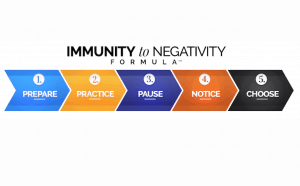Tina Hallis's Blog, page 20
October 13, 2019
It’s not fair! Why do I have to be the one to change?

Have you ever had to hit your brakes or swerve to avoid another car? Maybe you had the right-of-way at an intersection but the other vehicle didn’t yield like they were suppose to. In these situations, it’s easy to get upset. Even though you were doing everything right, you were the one who had to make a change to get the desired outcome; in this case, avoiding a collision. It isn’t fair!
The same holds true for our interactions with other people when we’re in person (and not in a car). We think we shouldn’t have to be the one to change. It just isn’t fair! Yet adapting to the situation by carefully choosing our response can help us get the outcome we desire and avoid a “cortisol collision.”
Yes, it would be nice if the other person would change, but it can be difficult to control other people. Instead, we can ask ourselves, What action can I take that would make this situation better? When we’re feeling frustrated or drained because of another person’s attitude or behavior, it can be difficult to see any good options. This week, reflect on possible choices ahead of time to make them more accessible in the moment.
Here are a few tools to try from the Choice step in the “Immunity to Negativity FormulaTM” –
Validate their feelings. Build rapport by coming from a place of concern and caring. Sometimes the greatest gift we can give someone is to truly listen so that they feel heard.
Set a time limit for them to vent. Ask what they want out of this conversation with you. How can you help?
Ask if everything’s OK. Instead of letting their bad mood trigger your bad mood, use this simple question.
Set boundaries from a place of compassion and patience, not frustration. Be ready to step back and not engage or fuel the drama.
Don’t react. If you remove their control over you, they may get bored. Psyching yourself up to be prepared for the negativity and not reacting can help.
Even though it feels unfair that you’re the one adapting and not them, remind yourself that taking time to Pause, Notice, & Choose a helpful response will make your life easier and the situation better for everyone.
Get more tools in the free videos from my course, Keep Your Positive Edge: How to Build Your Immunity to People’s Negativity.
October 6, 2019
News Bulletin: Watch Out! I’m Just Not Myself Today

What if we had a special pair of glasses that helped us see into people’s lives? Or maybe we could receive a news bulletin with the inside scoop about the people we are going to interact with today.
My friend seemed distracted and a little distant. The voice in my head wondered if she was mad at me. Or maybe she just wasn’t as excited to see me as she used to be. Maybe our friendship was fading. The reasons came streaming in.
Then she shared with me a wide variety of troubles that were on her mind. Some were serious health issues with close family members. Some were financial worries because of recent events in her life. She said, “I’m sorry that I’m just not myself today.”
My heart went out to her. I was so grateful that she had confided in me. No wonder she was acting differently!! It had nothing to do with me and nothing to do with the crazy ideas racing through my mind.
How often do we assume the worst and take it personally when people don’t behave the way we expect? We may never know what’s really going on with them, but it’s quite likely that it has nothing to do with us. So many people are struggling with worrisome issues related to their family, health, finances, relationships, jobs, etc. When I remember this, it’s easier for me to have more patience and tolerance when someone is grumpy, complaining, pessimistic, or reserved.
Awhile back, I saw this video. I really appreciated the part that starts around 1:40. It made me think. How would knowing that someone “was just not themself” change the way you might think about them, what you might say to them, and what you might do?
Try seeing beyond people’s outward “bad” behavior this week and consider what else might be going on in their lives. See if it changes your feelings about them.
September 29, 2019
We Were Stuck on the Plane but Not Going Anywhere = Rich Material

Does your day provide opportunities for you to practice staying positive? I call this “Rich Material.”
I was in my seat, waiting for the plane to depart. There was some commotion at the back of the plane so I looked back. I noticed that one of the panels over a seat was hanging down. Several people, including the flight attendant, were trying to push it back into place, but it just wouldn’t stay.
Then the announcement came over the intercom. They had called an engineer to fix it, but he was over an hour drive away so we would have to wait. People started to grumble. We were already late. Couldn’t someone else fix it? Couldn’t they just put some tape on it or move people out of that seat and just leave it? It seemed that the safety policy wouldn’t allow any of these options.
I had to smile to myself. This was rich material! I found it fascinating that the current book on mindfulness that I was reading on the plane (I can’t remember the title) was using this exact example! “If your plane is delayed and you’re worried about catching your connecting flight, it’s normal to get frustrated and upset. But feeling angry won’t get you there any faster or change what happens. You have the choice to become the observer of your thoughts and emotions instead of the participant.” So I was staying calm by observing my instinctive reaction and the reaction of my fellow passengers.
Isn’t it interesting how we can make ourselves frustrated over things that are out of our control? Some people remained fairly calm and others were loudly complaining. We were stuck on the plane but not getting any closer to our destination.
An hour passed; then another 30 minutes. The complaining grew even worse. Finally, they let the engineer on the plane. He strode to the back and quickly fixed the panel with a piece of duct tape. Seriously?? We’d been waiting all this time for a qualified expert to apply some duct tape? Ah!! More rich material…
Keep an eye out this week for the rich material in your life. When you find it, smile and see if you can become the observer instead of the participant. This is a tool in Step 2. Practice, from “The Immunity to Negativity FormulaTM.”
September 21, 2019
Work and Life Can Be Hard. Why Make Them Harder?

Take a moment right now to think of something that’s stressing you out. Maybe it’s a project or person at work. Maybe it’s something related to your family, finances, or health. Narrow it down to one thing that you wish you could change.
Now imagine that tomorrow morning, when you wake up, this thing that’s frustrating you is the first thought that enters your mind. You dwell on it as you get ready for work, as you drive to your job, and as you go through your day. Every spare minute, this negative thought is right there, at the front of your mind. You focus on it as you drive home and as you go to bed that night.
What kind of day would that be? It sounds like a hard day to me!
Now take a moment to think of something that you’re grateful for in your work or life. Maybe it’s a project at work that you enjoy or that person who is fun to be around. Maybe it’s something related to your family, home, or friends. Again, pick just one thing that makes you feel good.
Now imagine that when you wake up tomorrow, this positive thing is right there, at the forefront of your thoughts. And you continue to think about it as you head to work, as you interact with your coworkers, and as you prepare dinner that night. All day you’re thinking about how much you appreciate this person, thing, situation, etc. in your life.
How would this day be different from the other one? How might it affect how you feel, what you say, and even what you get done? But most importantly, which day do you want more of in your life?
If you’ve been to one of my talks, you may have participated in this “thought-experiment.” If you take the time to feel the difference between these two days, you get a sense of just how powerful our thoughts can be. Yet, how often do we think about what we think about?
Use this “thought-experiment” to motivate yourself to practice pausing and noticing. Because then we gain the power to choose what we focus on.
If you would like more ideas and tools to help you pause, notice, and choose your thoughts, get free access to the videos from my online course, Keep Your Positive Edge: How to Build Your Immunity to People’s Negativity for two weeks.
September 15, 2019
It Felt Like an Attack! I Needed to Carefully Choose My Response

Have you ever had a coworker or a family member snap at you and it felt like you were being attacked? What was your reaction? If you’re like most people, you probably got upset. It’s easy to say or do something out of anger or hurt when this happens, which only adds fuel to the fire.
I recently did a presentation that focused on helping people identify their priorities. At the end, I asked who could use help with their priority and then asked the group if anyone had expertise in that area. We made these connections for a few of the members.
Suddenly, one person spoke up complaining that they’d been a part of this networking group for years and had received little, if any help. This person spoke loudly and at length about their disappointment. It felt like an attack, and I noticed my insides getting tight and my own frustration rising.
I needed to remain calm, not say the sharp remark that was going through my mind, and address this discontent. So I was grateful for my recent practice of the “Pause and Notice” tools I’d learned. Now was the moment I needed them!
Choosing My Response
So I paused and noticed how I was feeling. Then I considered a couple of tools I’ve learned that could help me choose my response.
What kind of response would be in alignment with my values and who I want to be?
How could I reframe the situation so I could envision a new way of being?
I had to remember not to take their attack personally. Their emotions and issues were about them, not me.
I wanted my response to be helpful and positive. I reframed this person’s irritation and thought of it as passion for wanting this group to help each other more. I reminded myself that they were not angry with me. I remained calm, and the group ended up having a valuable discussion about ways to structure meetings so people could get to know each other’s expertise and needs even more.
This week, give steps 3 and 4 in the “Immunity to Negativity FormulaTM” a try. These are Pausing and Noticing in the moment when someone’s negativity is impacting your mood, your thoughts, and your reaction. Then consider the 5th step; Choose. What words and behavior would make things better for you, for the other person, for that team, group, or organization?
If you would like more ideas and tools to help you choose a response that makes things better, not worse, get free access to the videos from my online course, Keep Your Positive Edge: How to Build Your Immunity to People’s Negativity for two weeks.
September 8, 2019
Doing the Most Important Things When You’re Already Busy – Learning from the Dying

This week I’m excited to bring you a guest blog from a fellow speaker, Derek Deprey. This tip is from “Derek’s Dose” where he turns everyday moments into leadership lessons. I really enjoyed it and found it extremely valuable so I wanted to share.
I recently led a workshop called, “How to Do the Most Important Things When You’re Already Busy.” We worked through 10 different behaviors to ensure laser-focus on the things that deeply matter. Number six was, “Say No.”
I shared a story from author Bronnie Ware, who wrote the book, “The Top Five Regrets of the People Who Are Dying.” Ware spent 12 weeks caring for terminally ill people and would ask them what their top regrets were in life. Their number one regret was, “I wish I would have had the courage to live a life true to myself, not the life that others expected me to live.”
I want you to fast forward and think about yourself at age 80. Looking back, what do you wish that you would have done?
My challenge to you… Do that thing or do those things RIGHT NOW.
For me, it’s creating a “SAY YES list” 41 years before I turn 80. My “SAY YES list” includes my relationships, wellness, and personal development.
Once I know what I’m going to say yes to, I can more easily decide what I will say NO to. I want to say NO to TV, other people’s opinions of me, worry and negative news.
REFLECTION: Take a moment and think about what you want to say YES to, so that you can truly tackle those things and cut out the things in your life that you shouldn’t be wasting your valuable time on.
Derek Deprey is a speaker, author, and consultant who helps organizations create energized and effective cultures, so that they can fully realize their mission and vision. Learn more about him and his core philosophy of “Intentional Self-Leadership + Inspirational Team Leadership = Invigorating Culture” at DerekDeprey.com.
September 1, 2019
My Heart Was Pounding! Who Was Going to Jump Off the Cliff? Practicing Pausing & Noticing

Imagine you’re at the scene in Marvel’s Endgame where Hawkeye and the Black Widow realize that one of them has to sacrifice themselves by jumping off the cliff in Vomir to get the Soul Stone. Who’s it going to be? Are you really going to have to say goodbye to one of your favorite characters? You’re holding your breath when, suddenly, the power goes out.
Imagine you’re checking your social media page and you see that a friend is off on another vacation overseas. Didn’t they just get back from some great adventure? How come they get to go to so many amazing places? You’re thinking about other cool stuff your friend does and things they have that you don’t when there’s a knock on the door.
Imagine you just tuned into a favorite song on the radio that you haven’t heard in ages. A smile comes to your lips as you remember the words and melody. Then someone reaches over and changes the station.
What do these three scenarios have in common? OK. Maybe they’re all frustrating, but they’re also opportunities that provided a pause so you could notice your thoughts and feelings. Did you notice feeling anxious and sad for Hawkeye and the Black Widow? Did you notice feeling envious from the comparison with your friend? Did you notice going from feeling happy to upset when the radio station was changed?
These are critical skills, so that’s why they’re the second part of the Practice Step in the “Immunity to Negativity FormulaTM.” The more we do these steps when it’s “easy” or has a lower risk, the better we get.

Then, when we’re actually in a situation where we’re bombarded with someone else’s negativity, we have an improved ability to pause and notice in the moment (steps three and four). This is key to taking back our power and choosing how we respond instead of just reacting.
Give it a try this week. Look for “easy” opportunities to practice pausing and noticing and improve your skill.
August 25, 2019
I Didn’t Like Being Wrong. Name It to Tame It!
I have an embarrassing confession to make. Even though I’m in my 50s, I still have moments when I get my right and left mixed up. Just today I was driving to a meeting when my daughter who was navigating told me to take a right. As I started to take a left, she corrected me, “No! I said take a right!” Oops!
She started to tease me about not knowing my directions. My initial reaction was to get defensive. But she was right and I was wrong. My ego didn’t like being wrong. Luckily I was able to remember a great tool I’ve learned; “Name it to Tame It.”
I took a breath so I could pause and notice my defensiveness rising. Then I had a little conversation with myself. Seriously, Tina! You do get confused about your directions some times. She’s right, it is ridiculous and funny. You’re feeling defensive. That’s a normal reaction when your ego’s been bruised.
As I tuned into my reaction, it was easier for me to stay calm and make light of my mistake. Instead of getting upset or feeling hurt, I said, “It’s crazy how I can still get confused. You better just point in the direction you want me to go!”
is a term coined by author and psychiatrist Dr. Daniel Siegel. The idea is that naming how you’re feeling can help you detach and observe rather than react. It helps you realize that your emotions are your issues and to not blame the other person. This is one of my favorite tools in the Practice step of the Immunity to Negativity FormulaTM . The more we practice this tool, the easier it gets. And, as one of my favorite sayings goes, life is going to give you lots of opportunities to practice!
Be on the lookout this week. See if you can find moments when you can pause, notice your defensiveness or frustration kicking in, and then practice naming it to tame it.
August 18, 2019
This Driver Is Making Me Late and Frustrated! Is He My Teacher??

The other day I was making the hour drive from my hometown into the big city of Madison, WI. Most of it is a four-lane state highway so I can cruise right along. But this day there was road construction that had several miles of the road closed down to two lanes. I had an appointment and I didn’t have time to waste. Sure enough, I ended up behind someone who thought they should drive at least 10 miles per hour below the speed limit. Not only were they making me late, they were making me frustrated. “Hurry up! You don’t need to go this slow!!”
Can you relate?
I managed to pause and notice what I was thinking and how I was feeling. Suddenly, I remembered a tool from the Prepare step in my Immunity to Negativity FormulaTM
Other people don’t make you upset, you let them make you upset.
It’s a blunt way to say that we are responsible for our own reaction and ultimately we have the ability to choose how we respond. I’m sure you’ve heard this before, but how often do we remember it when we need it? This slow driver was giving me an opportunity to remember that I had a choice. I could prepare my mindset by remembering this tool and seeing them as my teacher.
Flipping how we think about someone who’s making us frustrated can sound crazy at first. Society and my survival instinct were telling me that I had every right to feel upset with this driver. But deep down I also knew that feeling frustrated wasn’t going to change the situation. I couldn’t pass them in this road construction. I couldn’t make them go faster. If I was late, I was late. Arriving stressed was my choice.
This is where the Prepare step pays off. Time and again, I’ve learned that it takes courage and effort to take responsibility for our own response; internally (how we feel) and externally (what we say and do). It’s normal and easier to blame someone else (the other driver!). It can be a big mindset shift to realize we can override our natural reaction and take back our power instead of letting someone else control how we feel.
I guarantee you that life is going to give you opportunities to practice this tool this week. See if you can pause and notice these moments and see the other person as a teacher who is reminding you that you can choose how you respond internally and externally.
August 11, 2019
I Don’t Want to Hear About this Positivity Hocus Pocus!

10 Years Ago
Let’s go back in time to about 10 years ago. I was working in my corporate job as a scientist in biotechnology. I had never heard of Positive Psychology, and I had little if any interest in personal development or self-help topics. I was enjoying my work and was pretty satisfied with my life overall. If someone had told me that I could be happier, that I could have less stress and more joy, I might have been a little curious, but I would have passed. After all, I was in my 40s; a little late to make any changes. And I was happy enough, wasn’t I? Also, I would have thought it sounded like a lot of hocus pocus.
At that time in my life, I wouldn’t have been interested or ready to learn more. But in the next couple of years, things changed. We were having lots of layoffs at my company. There were rumors our site was going to be shut down because of a recent merger. Morale was low. I had a new boss that didn’t seem to appreciate my talents or hard work. So in 2011, when I stumbled upon Shawn Achor’s book, The Happiness Advantage, I was in a different place; I was ready for something new.
Discovering Positive Psychology
Not only that, this book was my first introduction to a new science called Positive Psychology with studies and research on how and why to be more positive. It wasn’t hocus pocus and I was hooked! I was super excited to learn more and to start applying all the great insights and strategies I was reading. And because I could understand and feel the impact it had, I wanted to share it with others. I knew it could help everyone!
Or could it? What if they weren’t interested or ready? What if they were satisfied with their current life like I had been?
An Important Lesson
This is a lesson I have to constantly remember; I don’t always know what’s best for others. I might think I know what would make them happier, healthier, maybe even wealthier, but everyone is in a different place. Have you ever had these thoughts? It can be especially hard when it’s someone close to us. What I’ve learned is that it can be more impactful to accept them for who they are and where they are right now.
Realizing we don’t always know what’s best because we’re all different is one of the many helpful tools in Step 1 of the “Immunity to Negativity Formula” – Prepare.

Last week’s tip talked about this formula, where it came from and the first part of the Prepare Step, charging our positivity battery. The second part of Prepare is all about shifting our perspective. We have the ability to change the way we see other people and the situation. When we take the time to consider a new way of thinking while we’re calm and feeling good, it will be easier to remember it when we’re with the person we want to change.
Who are you trying to change because you think you know what’s best for them?



